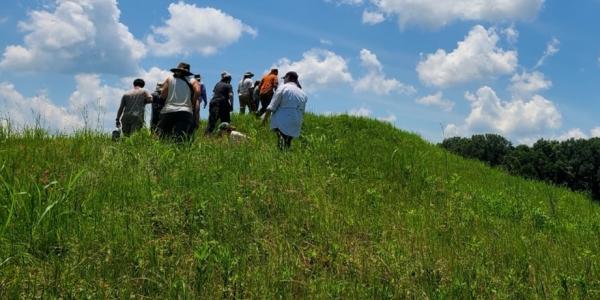WashU researchers suggest new explanations for iconic prehistoric sites.
Some 3,500 years ago, hunter-gatherers began building massive earthwork mounds along the Mississippi River at Poverty Point, a UNESCO World Heritage Site in Northeast Louisiana. “Conservatively, they moved 140,000 dump truck loads of dirt, all without horses or wheels,” said Tristram “T.R.” Kidder, the Edward S. and Tedi Macias Professor and a professor of anthropology. “It was incredibly hard work. The big question is why? What was their motivation?”
After revisiting Poverty Point and nearby sites, gathering radiocarbon dates, and rethinking the archaeological record, Kidder and his team are suggesting new theories that challenge previous assumptions about these communities.
Kidder shared his theories and the evidence behind them in two new papers in the journal Southeastern Archaeology. His co-authors include Olivia Baumgartel, a graduate student in archaeology, and Seth Grooms, PhD ’23, a former WashU graduate student now at Appalachian State University.

Poverty Point is famous for its giant mounds, still clearly visible today. But the smaller details are just as remarkable: Archaeologists have found thousands of clay-fired cooking balls and materials from distant regions, including quartz crystal from Arkansas, soapstone from the Atlanta area, and personal adornments made from Great Lakes copper. “These people were trading and traveling over long distances,” Kidder said.
Previous thinking held that building Poverty Point required a highly complex, hierarchical society with multiple generations of laborers. Archaeologists know that the people who built Cahokia Mounds — another massive earthwork project constructed more than 1,000 years after Poverty Point — were ruled by a chiefdom, so it was easy to assume that Poverty Point’s builders had a similar political system. But in archaeology, easy explanations are not always correct.


In their new paper, Kidder and Grooms suggest a different interpretation: Instead of a long-occupied settlement with chiefs and laborers, Poverty Point was a temporary gathering spot where people from across the Southeast and Midwest assembled by the thousands to trade, socialize, work, and worship together.
The paper builds on theories Kidder and his team of graduate students have been developing for years. Based on the evidence, they see a community with a shared sense of purpose. “We believe these people were egalitarian hunter-gatherers, not subjects to some powerful chiefdom,” Baumgartel said.
The massive earthworks weren’t monuments to a ruling class, Kidder said. Instead, they were a cooperative effort over several years to gain favor with an unpredictable universe. “When these earthworks were being constructed, the Southeast was prone to severe weather and massive floods,” he said. “We believe the inhabitants of Poverty Point built the mounds, performed rituals, and left behind valuable objects as a sacrifice and spiritual offering.”
Kidder and Grooms note that archaeologists have never found burial sites or remains of long-term dwellings at Poverty Point. “We would expect to see those things if this were a permanent village,” Kidder said. “The old paradigm that people lived at Poverty Point continuously for centuries has been crumbling, and we needed a new framework.”
Unlike pots and beads, spiritual intentions can’t be dug up and examined under a microscope. But Kidder and Grooms have good reason to believe the earthworks and objects at Poverty Point had deeper significance. “I’ve spent many years talking with people of Native American ancestry,” Kidder said. That includes Grooms, a member of the Lumbee tribe of North Carolina.
Those conversations have strengthened his theory that the people of Poverty Point had a religious motivation that doesn’t fit modern concepts of utility.

“As archaeologists, we have to leave ourselves open to different kinds of thinking,” Kidder said. “The Western view is that they wouldn’t travel all of that distance and do all of that work unless they were getting something of economic value out of it. We believe they felt a moral responsibility to repair a torn universe.”

Unique histories
Poverty Point wasn’t the only gathering place in the region. WashU researchers are also studying Claiborne and Cedarland, archaeological sites in Western Mississippi that once held similar troves of artifacts. Both have been damaged by land development and souvenir seekers. “It’s a sad fact that in archaeology today, you’re almost always trailing behind someone’s bulldozer,” Kidder said.
Rather than further disturbing the sites, the team used radiocarbon dating technologies to gauge the age of clam shells and deer bones collected from the Claiborne and Cedarland sites by archaeologists some 50 years ago. The tests revealed that people occupied Cedarland about 500 years before either Claiborne or Poverty Point, showing it had its own independent history. “We’ve pulled these sites apart, given them independent histories, and have started to understand how artifacts from across the region ended up here,” Baumgartel said.
This meticulous approach continues at Poverty Point. In May and June of this year, Kidder and Baumgartel re-excavated pits originally dug in the 1970s. Using new radiocarbon dating and microscopy techniques, they hope to uncover insights past researchers could not.
“Olivia and I spent a lot of time moving tiny amounts of dirt, and it was hot and tiring,” Kidder said. “It’s incredible to think about the effort that the people of Poverty Point went through to build those earthworks. They continue to inspire me.”





